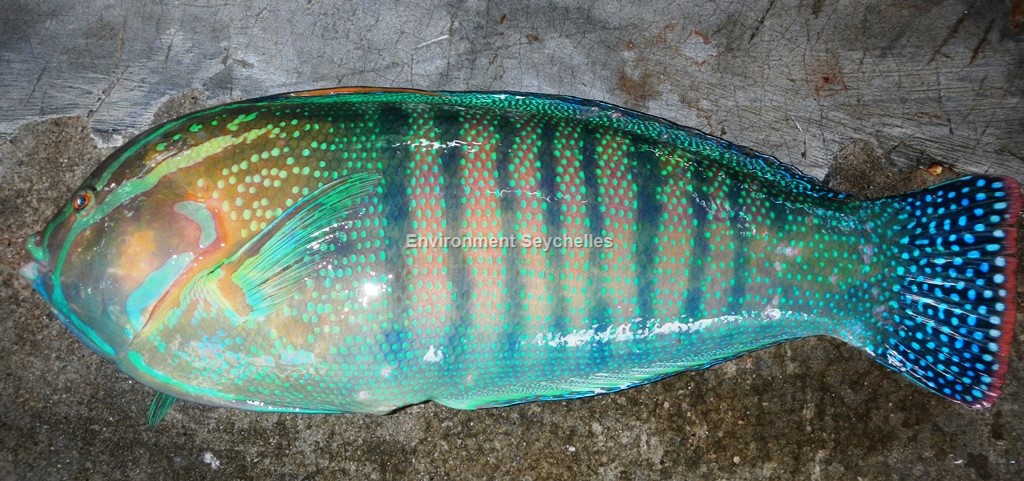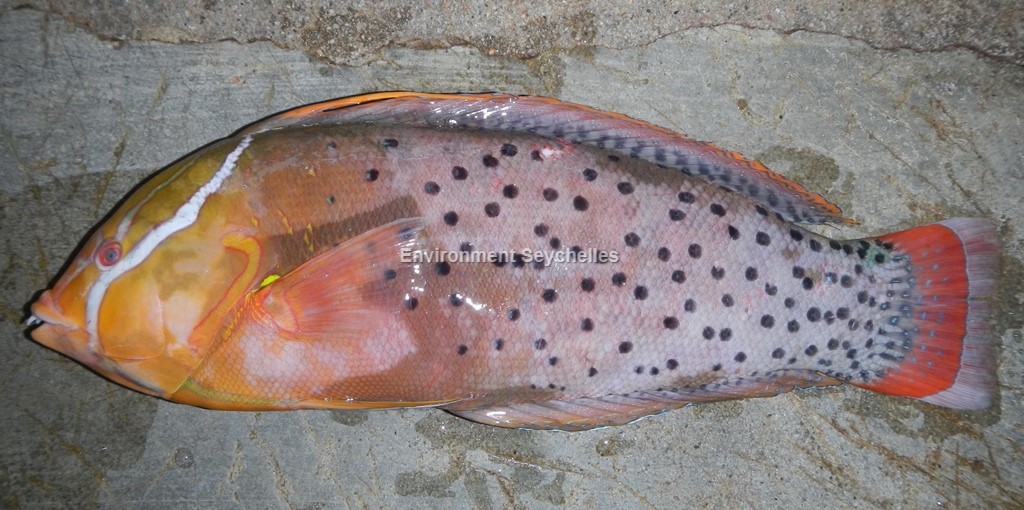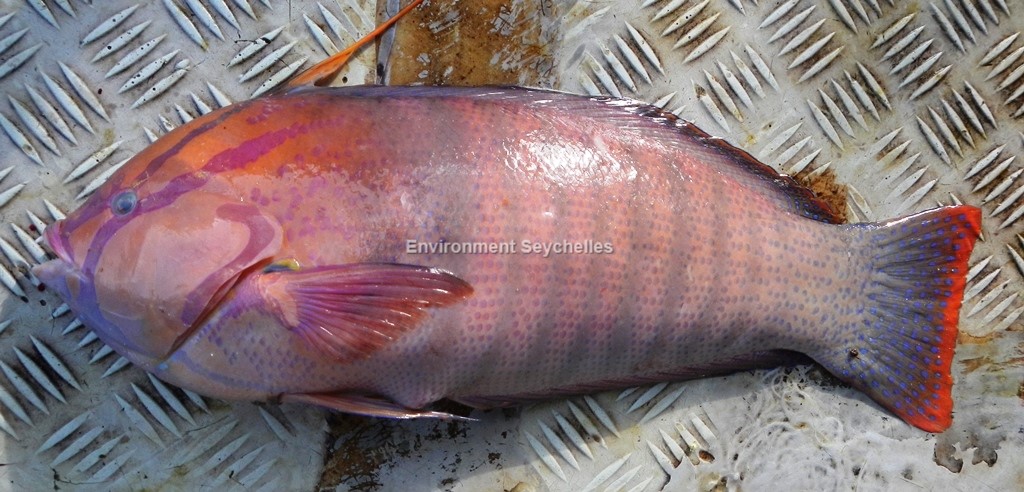Description:
Dorsal spines: 9; Dorsal rays: 12; Anal spines: 3; Anal rays: 12.
Moderately slender-bodied wrasse. Dorsal profile of head slightly convex. 2 prominent canines at anterior of each jaw, subsequent progressively smaller. 1 or 2 separate
canines present on each side at rear of upper jaw. Cheek, opercle and lower jaw without scales. Dorsal fin continuous, first 2 spines in large individuals considerably
longer with trailing filament. Pelvic fins filamentous in large individuals. Caudal fin truncate to slightly rounded.
Colour.
Initial Phase. Body base colour varies from olive grey to lavender with numerous relatively evenly spaced black spots most as large as eye, becoming smaller on the caudal
peduncle and also on the proximal portions of the dorsal and anal fins. Black spots become ocelli on caudal fin with bright blue centres. Anterior portion of body
progressively brownish to orangish on head. Striking electric blue or green stripe runs from anterior base of dorsal fin across face below eye and then down behind mouth
to edge of opercle. A second narrow line originates from same point running to top of eye and then anterior to eye, may bifurcate. Distinctive bright yellow green patch
at upper edge of pectoral fin axis. Bright orange trailing filament from first two spines of dorsal fin. Caudal fin red with black-edged blue spots and broad lavender margin.
Terminal Phase: Body base colour can vary from orange through reddish to lavender. They share the distinctive stripes on the head as described for the Initial phase
(although colour may vary, see photos) and the shading to orange colour anteriorly. Exhibit 8 to 10 characteristic dark bars on sides of large individuals. Flanks speckled
with black to brilliant blue or green spots. Trailing filament from first 2 spines of dorsal fin bright orange. Distinctive bright yellow-green patch at top of pectoral
fin axis. Caudal fin dark with small, dark-edged, blue-green spots, posterior margin light orange-red.
These descriptions do not even begin to do justice to the rich colours and pattern of these stunning and very distinctive fish… see photos.
Juveniles orange, head and lower part of body dark brown; 3 large, vertically elongate, broadly black-edged, white spots on dorsal part of body.
Size:
Maturity: Lm unknown. Range unknown. Max Length: 60 cm TL.
Habitat and Ecology:
Inhabits weed and rock or coral areas (depth 2-30m). Juveniles are common in shallow rocky tide pools. Adults are solitary in habit. Feeds mostly on hard-shelled prey,
including crustacea, molluscs and sea urchins. Oviparous, with distinct pairing during breeding.
Fishery Status:
This species is not protected or subject to fishery regulations. It is caught in the hand line fishery, but is an uncommon component of the catch.
Notes:
References:
Craig, M.T. (2010). Coris formosa. The IUCN Red List of Threatened Species 2010: https://dx.doi.org/10.2305/IUCN.UK.2010-4.RLTS.T187664A8594629.en. (05/03/20).
Froese, R. & D. Pauly. (Eds.) (2018). FishBase. https://www.fishbase.se/summary/Coris-formosa (04/06/19).
Randall, J.E. (1986). Labridae. p. 683-706. In M.M. Smith and P.C. Heemstra (eds.) Smiths' sea fishes. Springer-Verlag, Berlin.
Citation:
Nevill, J.E.G. (2019). Coris formosa, Queen coris wrasse. Seychelles Seatizens. www.seatizens.sc. https://seatizens.sc/species/coris-formosa-bennett-1830/ (edited 10/07/22).




Chơi Sicbo vui, tỷ lệ thắng ổn.
Chơi Sicbo vui, tỷ lệ thắng ổn.
Các trò chơi đa dạng, giải trí tốt
Idol TikTok khoe thân: Hậu quả tâm lý sau scandal lộ hình ảnh
App di động chơi mượt, không lag
Nhà cái az888 luôn mang đến cơ hội thắng lớn cho mọi người
Great blog post. Really Great.
Trải nghiệm tốc độ cực nhanh khi truy cập https://bsport.blue/
Mình không ủng hộ các nội dung lừa đảo và tuyển dụng giả mạo.
Web và app hoạt động mượt mà, đáng tin cậy
Thể thao trực tuyến nhiều kèo hấp dẫn.
Chăm sóc khách hàng tận tình 24/7.
Hướng dẫn chi tiết, người mới chơi dễ tiếp cận
Nạp tiền đơn giản, tiền về nhanh
Hướng dẫn chơi chi tiết, người mới dễ học
Các trò chơi cập nhật thường xuyên, không nhàm
Các trò chơi Vuabet đa dạng, không chán
ketamin bị lạm dụng gây nghiện nặng
Jun888 – Game nổ hũ, bắn cá, slot hấp dẫn
Nhà cái uy tín Jun88 – Game bài, poker, slot hấp dẫn
Okvnd thưởng chào mừng
TikTok khiêu dâm trá hình: Nhận diện và báo cáo nội dung độc hại
Trải nghiệm game slot siêu vui cùng az888
Các trò chơi tại 98WIN được phân loại rõ ràng
bsport – Nơi hội tụ đam mê và cơ hội chiến thắng
Tham gia cộng đồng người chơi đông đảo tại 88nn
Top ưu đãi nạp đầu dành cho hội viên 88vv
tf88 – Thế giới cá cược thể thao hấp dẫn, đa dạng kèo
Az888 poker Texas Hold’em
88vv ví điện tử tiện lợi
Nạp qua thẻ cào tiện cho ai không có ví.
88vv cầu lông SEA Games
tf88 jackpot triệu đồng
sinh viên bán dâm: Sinh viên bán dâm là thực trạng đáng báo động, gây hại tương lai.
app cho vay bị sập: App cho vay sập bất ngờ khiến người vay rơi vào cảnh nợ nần.
tf88 PAGCOR hợp pháp
kho ảnh nóng gái xinh giả mạo
ketamin: Sử dụng ketamin bất hợp pháp đe dọa nghiêm trọng đến sức khỏe.
nhà nghỉ kín Sài Gòn: Nhà nghỉ kín ở Sài Gòn thường che đậy hoạt động không lành mạnh.
Nội dung 18+ trá hình trên TikTok dễ khiến giới trẻ lệch lạc trong suy nghĩ, nên ưu tiên sáng tạo nội dung ý nghĩa, lành mạnh.
Mại dâm trá hình qua app hẹn hò hay các nhóm sugar baby gây hệ lụy xã hội, cần nâng cao nhận thức về giá trị bản thân.
Việc booking gái hay mại dâm trá hình qua app hẹn hò gây hệ lụy xã hội, nên tập trung vào các mối quan hệ lành mạnh, chân thành.
Streamer lộ hàng hay khoe thân để câu view thiếu bền vững, nên xây dựng hình ảnh bằng tài năng và nhân cách.
Nội dung 18+ trá hình trên TikTok dễ khiến giới trẻ lệch lạc trong suy nghĩ, nên ưu tiên sáng tạo nội dung ý nghĩa, lành mạnh.
Web luôn cập nhật các trò chơi mới và hấp dẫn.
I appreciate you sharing this post.Thanks Again. Will read on…
I really enjoy the article. Keep writing.
I am so grateful for your post.Thanks Again.
Idol khoe thân lộ clip bị phát tán
Scam Telegram giả celeb lừa donate
App vay vỡ nợ đòi bằng kiện tụng
Clip nóng phát tán phá hủy danh dự
Tín dụng đen cho sinh viên phá hoại tương lai
Enjoyed every bit of your article.Really looking forward to read more. Keep writing.
Thanks a lot for the blog.Much thanks again.
Fantastic article.Thanks Again. Fantastic.
Great blog post.Much thanks again. Really Cool.
Thanks a lot for the blog post.Really thank you! Keep writing.
I truly appreciate this article post.Thanks Again. Will read on…
Trải nghiệm mượt mà trong từng thao tác
Thanks a lot for the blog post.Really thank you! Great.
Thanks again for the blog post.Thanks Again. Fantastic.
I cannot thank you enough for the article post.Much thanks again. Want more.
Really enjoyed this blog.Much thanks again. Great.
A round of applause for your blog. Really Great.
Awesome blog article.Really looking forward to read more. Awesome.
Major thanks for the blog article.Much thanks again. Keep writing.
Hiếp dâm trẻ em gái mang thai dị dạng
Ăn thịt người prion não teo điên loạn
Very informative blog post.Really thank you! Great.
Chỗ bán thuốc lắc Sài Gòn đầy cạm bẫy
I really enjoy the blog post.Really looking forward to read more. Awesome.
Hey, thanks for the article post.Much thanks again.
Thanks for sharing, this is a fantastic blog article.Really thank you! Want more.
Người chơi bị hạn chế quyền truy cập không rõ lý do.